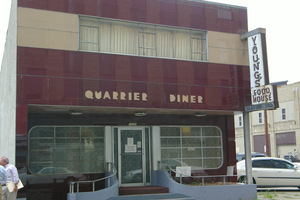 | Back to e-WV
| Back to e-WV
 The West Virginia Encyclopedia
The West Virginia Encyclopedia
 | Back to e-WV
| Back to e-WV
 The West Virginia Encyclopedia
The West Virginia Encyclopedia

Vitrolite is a trade name for structural pigmented glass, a popular building material during the first half of the 20th century. Vitrolite was a West Virginia product, manufactured after 1908 by the Meyercord-Carter Company in Vienna, Wood County. The firm reorganized in 1910 as the Vitrolite Company, and the factory was fully completed in 1914. The company’s products became popular after a 1922 Washington exposition on Vitrolite. The glass giant Libbey-Owens-Ford bought the Vitrolite Company in 1935 and continued production until 1947.
Structural glass was originally developed in 1900 as a sanitary substitute for marble in wainscoting and table-top applications by the Marietta Manufacturing Company of Indianapolis, followed by Pittsburgh Plate Glass, Penn-American Plate Glass, and others. PPG’s Carrara Glass and Vitrolite were the industry giants. Structural glass, applied in heavy panels, was widely used for interior and exterior siding and veneer applications, especially in rehabilitating older storefronts in many downtowns. LOF co-sponsored a ‘‘Modernize Main Street’’ competition with Architectural Record magazine in the 1930s, encouraging such use of Vitrolite.
White and black were the first colors available. In the 1930s, these gave way to other hues, including pastels and jewel tones. The material was an integral element of the Art Deco, Art Modern, and Streamlined architectural styles. The market for structural pigmented glass declined in the early 1950s with the advent of other materials.
Written by Michael Gioulis